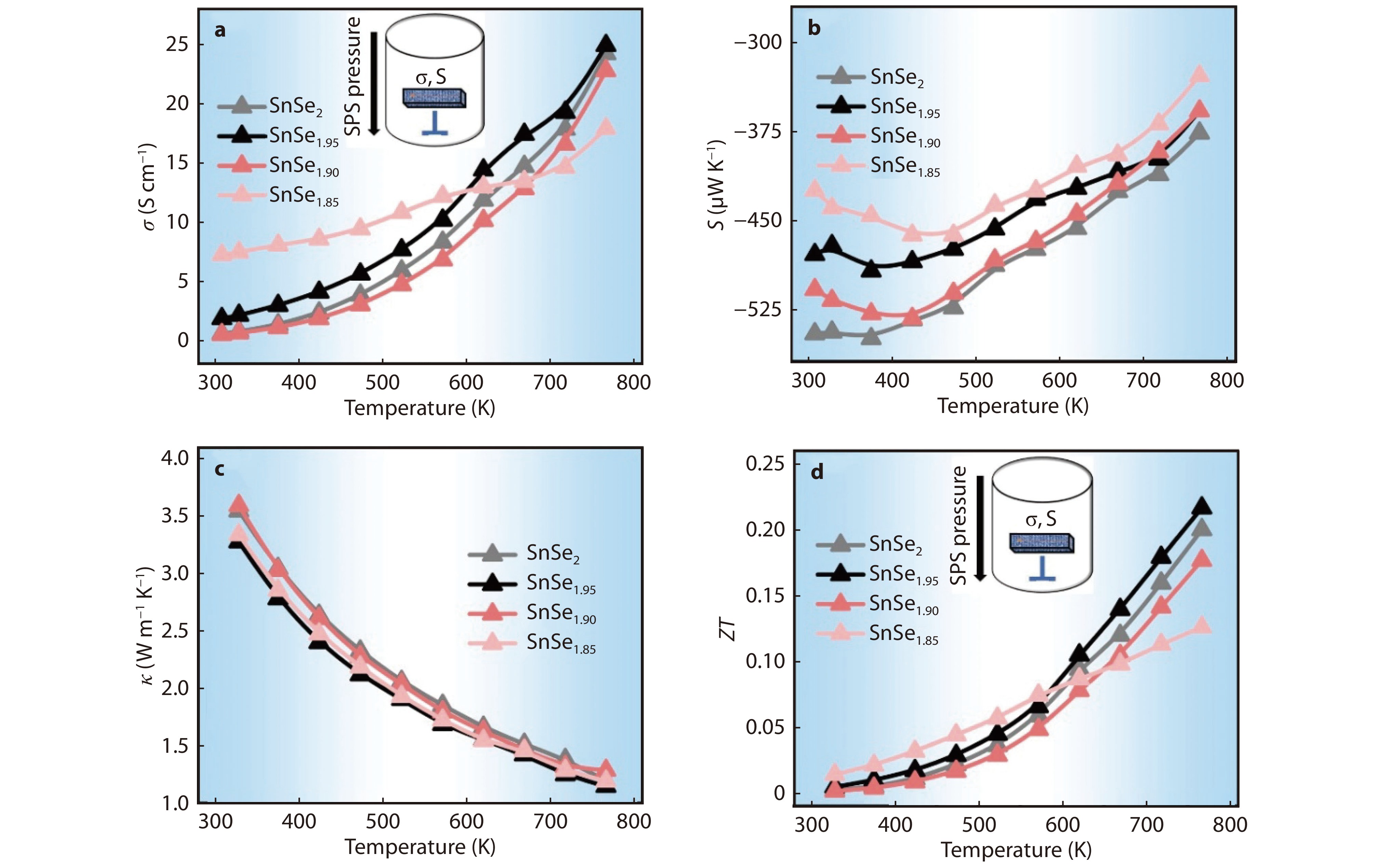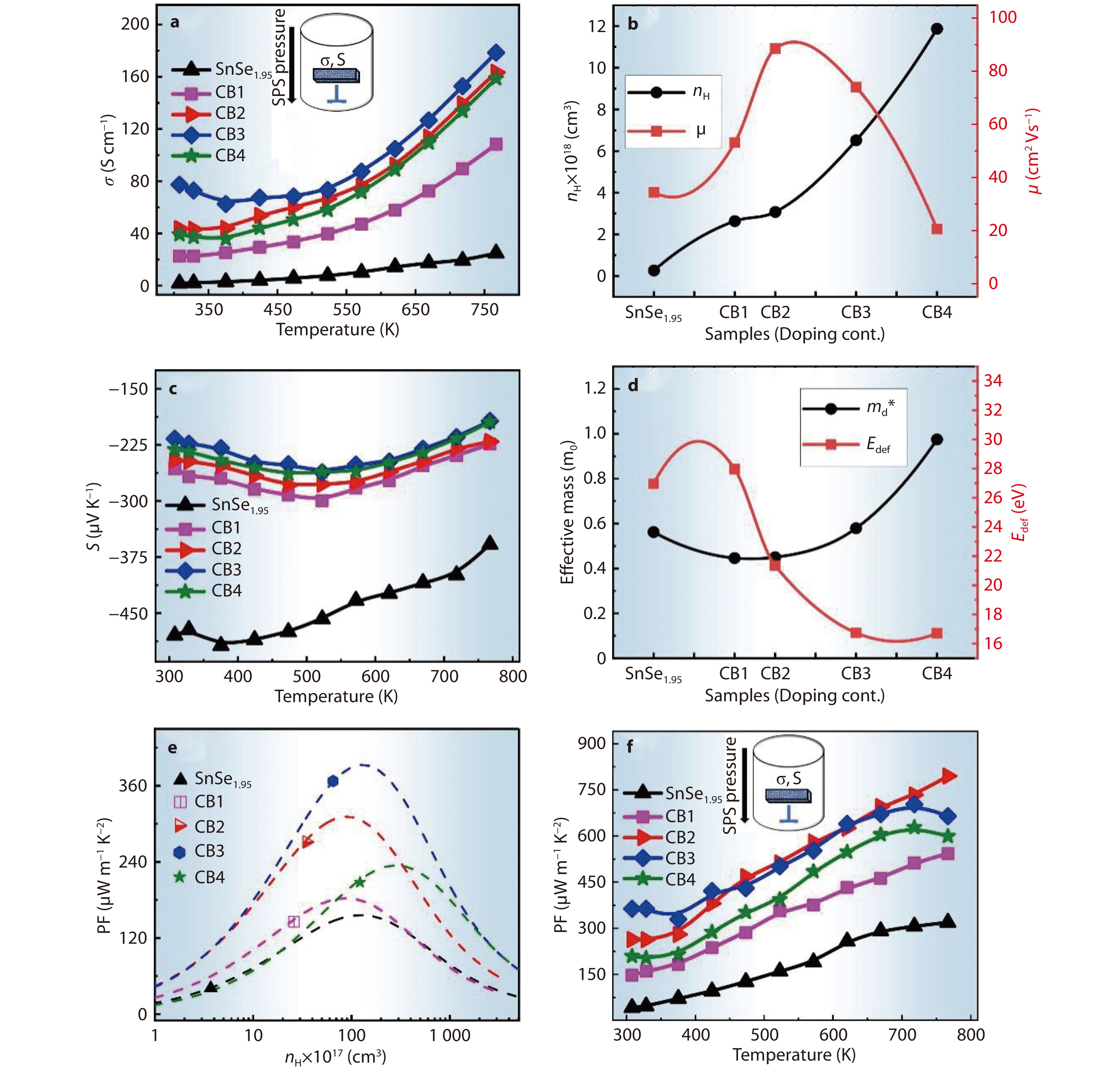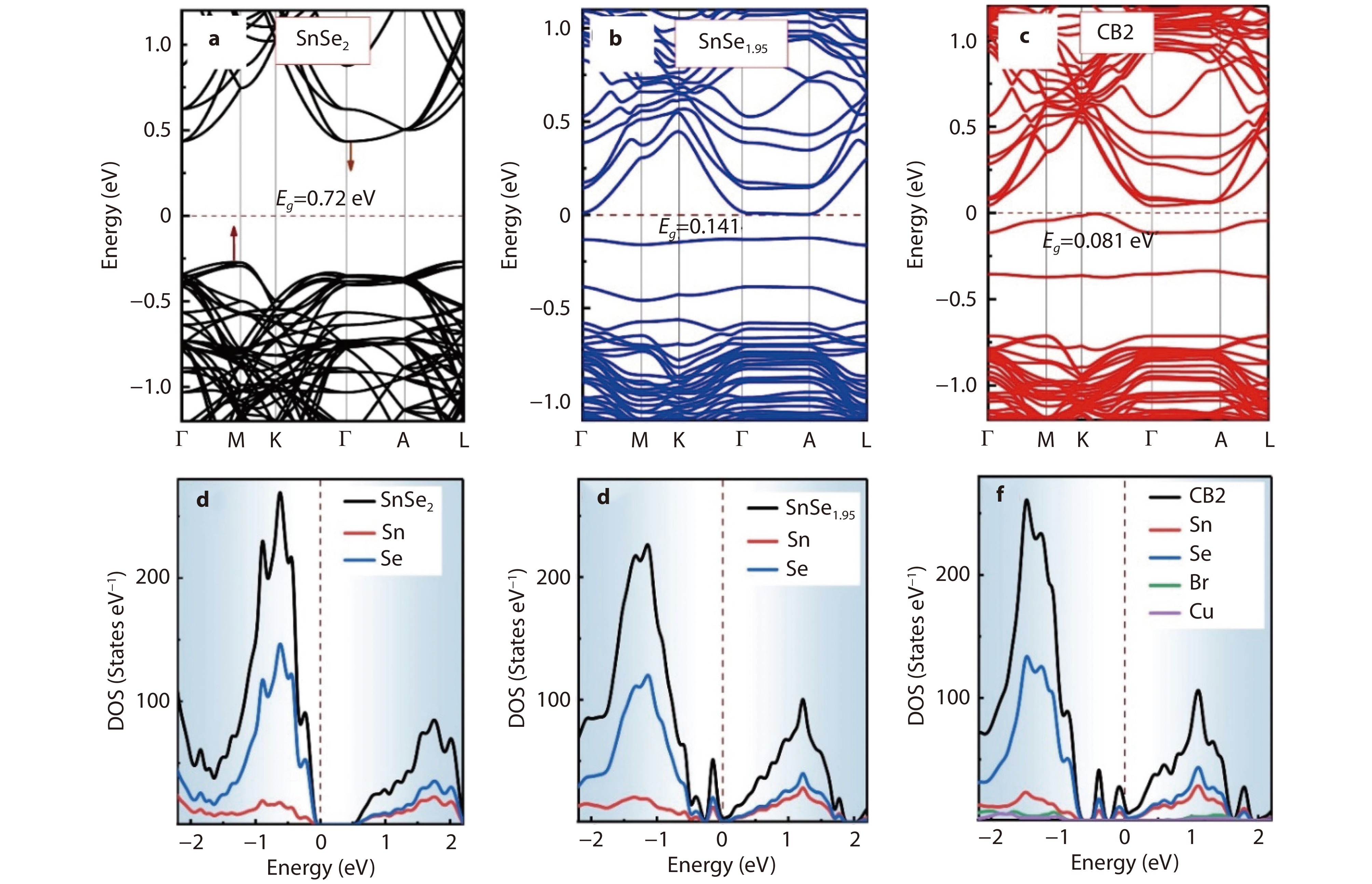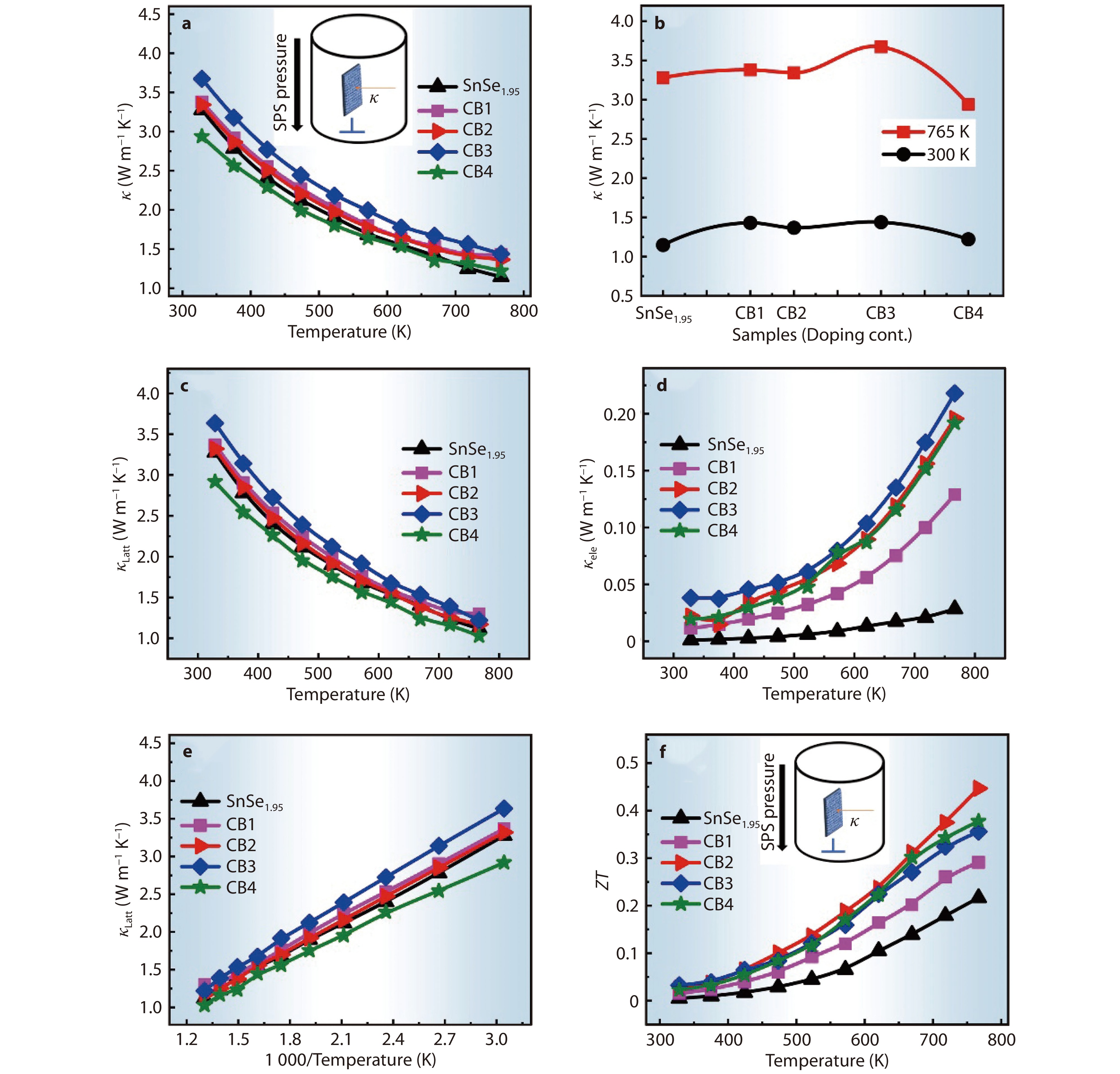| Citation: | Mohammad Nisar, Wenning Qin, Junze Zhang, Zhuanghao Zheng, Fu Li, Guangxing Liang, Ping Fan, Yue-Xing Chen. Synergistic optimization of thermoelectric performance in SnSe2 through Co-doping: anionic vacancy formation and band engineering[J]. Materials Lab, 2024, 3(1): 230023. doi: 10.54227/mlab.20230023 |
Synergistic optimization of thermoelectric performance in SnSe2 through Co-doping: anionic vacancy formation and band engineering
-
Abstract
SnSe2 is a layered crystal structure material that is abundant in the Earth's crust and considered non-toxic. However, its thermoelectric properties are anisotropic due to the differences in its interlayer and intralayer electrical and thermal transport properties. The intrinsically poor thermoelectric performance of SnSe2 can be attributed to its lower electrical transport properties in its pristine condition. To address this, we developed a method involving combined mechanical alloying (MA) and spark plasma sintering (SPS) to synthesize n-type Sn-rich Cu-Br co-doped SnSe2 polycrystals. Optimization of Sn enrichment facilitated superior material selection for subsequent doping. The resulting substitutional doping induced a substantial rise in carrier concentration, leading to improved thermoelectric performance. Notably, the power factor displayed a significant increase, reaching approximately 795 µW m−1 K−2 at 765 K through Cu-Br co-doping. Furthermore, density functional theory (DFT) analysis elucidated a reduced bandgap and increased degeneracy within the electronic band structure and density of states, affirming the enhancement of thermoelectric properties in Cu-Br co-doped Sn-rich SnSe2 polycrystals. Finally, a maximum figure of merit (
ZT ) value of 0.46 was achieved at 765 K for the Sn0.985Cu0.015Se1.92Br0.03 sample, perpendicular to the SPS pressing direction, which was nearly threefold higher than the pure SnSe1.95. This compelling outcome highlights the improved thermoelectric performance of the co-doped SnSe2 polycrystals.-
Keywords:
- SnSe2 /
- Sn-enrichment /
- Bromine Copper co-doping /
- Thermoelectric Properties /
- DFT
-

-
References
1. G. J. Snyder, E. S. Toberer, Nature Materials, 2008, 7, 105 2. D. M. Rowe, Renewable Energy, 1999, 16, 1251 3. J. Choi, Y. Jung, S. J. Yang, J. Y. Oh, J. Oh, K. Jo, J. G. Son, S. E. Moon, C. R. Park, H. Kim, ACS Nano, 2017, 11, 7608 4. J. Jung, E. H. Suh, Y. J. Jeong, H. S. Yang, T. Lee, J. Jang, ACS Applied Materials & Interfaces, 2019, 11, 47330 5. J. S. Son, H. Zhang, J. Jang, B. Poudel, A. Waring, L. Nally, D. V. Talapin, Angewandte Chemie International Edition, 2014, 53, 7466 6. S. Jo, S. H. Park, H. W. Ban, D. H. Gu, B.-S. Kim, J. H. Son, H.-K. Hong, Z. Lee, H.-S. Han, W. Jo, J. E. Lee, J. S. Son, Journal of Alloys and Compounds, 2016, 689, 899 7. Y. Zhang, Y. Chen, C. Gong, J. Yang, R. Qian, Y. Wang, Journal of Microelectromechanical Systems, 2007, 16, 1113 8. H. J. Goldsmid, The Physics of Thermoelectric Energy Conversion, Morgan & Claypool Publishers, America, 2017. 9. A. D. LaLonde, Y. Pei, H. Wang, G. Jeffrey Snyder, Materials Today, 2011, 14, 526 10. J. R. Sootsman, D. Y. Chung, M. G. Kanatzidis, Angewandte Chemie International Edition, 2009, 48, 8616 11. Z. Yu, X. Wang, C. Liu, Y. Cheng, Z. Zhang, R. Si, X. Bai, X. Hu, J. Gao, Y. Peng, L. Miao, Journal of Advanced Ceramics, 2022, 11, 1144 12. Z.-H. Zheng, D.-L. Zhang, B. Jabar, T.-B. Chen, M. Nisar, Y.-F. Chen, F. Li, S. Chen, G.-X. Liang, X.-H. Zhang, P. Fan, Y.-X. Chen, Materials Today Physics, 2022, 24, 100659 13. Z.-G. Chen, X. Shi, L.-D. Zhao, J. Zou, Progress in Materials Science, 2018, 97, 283 14. S. Singh, S. Lee, H. Kang, J. Lee, S. Baik, Energy Storage Materials, 2016, 3, 55 15. Y. Sadia, Z. Aminov, D. Mogilyansky, Y. Gelbstein, Intermetallics, 2016, 68, 71 16. G. Tan, L.-D. Zhao, M. G. Kanatzidis, Chemical Reviews, 2016, 116, 12123 17. Q. Zhang, B. Liao, Y. Lan, K. Lukas, W. Liu, K. Esfarjani, C. Opeil, D. Broido, G. Chen, Z. Ren, Proceedings of the National Academy of Sciences, 2013, 110, 13261 18. L. D. Hicks, M. S. Dresselhaus, Physical Review B, 1993, 47, 12727 19. M. Christensen, A. B. Abrahamsen, N. B. Christensen, F. Juranyi, N. H. Andersen, K. Lefmann, J. Andreasson, C. R. H. Bahl, B. B. Iversen, Nature Materials, 2008, 7, 811 20. Y. Liu, W. Wang, J. Yang, S. Li, Advanced Sustainable Systems, 2018, 2, 1800046 21. M. Samanta, T. Ghosh, S. Chandra, K. Biswas, Journal of Materials Chemistry A, 2020, 8, 12226 22. F. Guo, B. Cui, H. Geng, Y. Zhang, H. Wu, Q. Zhang, B. Yu, S. J. Pennycook, W. Cai, J. Sui, Small, 2019, 15, 1902493 23. L. Xie, D. He, J. He, Materials Horizons, 2021, 8, 1847 24. W. He, D. Wang, H. Wu, Y. Xiao, Y. Zhang, D. He, Y. Feng, Y.-J. Hao, J.-F. Dong, R. Chetty, L. Hao, D. Chen, J. Qin, Q. Yang, X. Li, J.-M. Song, Y. Zhu, W. Xu, C. Niu, X. Li, G. Wang, C. Liu, M. Ohta, S. J. Pennycook, J. He, J.-F. Li, L.-D. Zhao, Science, 2019, 365, 1418 25. B.-Z. Sun, Z. Ma, C. He, K. Wu, Physical Chemistry Chemical Physics, 2015, 17, 29844 26. F. Li, Z. Zheng, Y. Li, W. Wang, J.-F. Li, B. Li, A. Zhong, J. Luo, P. Fan, Journal of Materials Science, 2017, 52, 10506 27. Y. Luo, Y. Zheng, Z. Luo, S. Hao, C. Du, Q. Liang, Z. Li, K. A. Khor, K. Hippalgaonkar, J. Xu, Q. Yan, C. Wolverton, M. G. Kanatzidis, Advanced Energy Materials, 2018, 8, 1702167 28. Y. Wu, W. Li, A. Faghaninia, Z. Chen, J. Li, X. Zhang, B. Gao, S. Lin, B. Zhou, A. Jain, Y. Pei, Materials Today Physics, 2017, 3, 127 29. G. Li, G. Ding, G. Gao, Journal of Physics:Condensed Matter, 2017, 29, 015001 30. Z. Fang, S. Hao, L. Long, H. Fang, T. Qiang, Y. Song, CrystEngComm, 2014, 16, 2404 31. P. Yu, X. Yu, W. Lu, H. Lin, L. Sun, K. Du, F. Liu, W. Fu, Q. Zeng, Z. Shen, C. Jin, Q. J. Wang, Z. Liu, Advanced Functional Materials, 2016, 26, 137 32. L.-D. Zhao, S.-H. Lo, Y. Zhang, H. Sun, G. Tan, C. Uher, C. Wolverton, V. P. Dravid, M. G. Kanatzidis, Nature, 2014, 508, 373 33. Y. Qin, T. Xiong, J.-f. Zhu, Y.-l. Yang, H.-r. Ren, H.-l. He, C.-p. Niu, X.-h. Li, M.-q. Xie, T. Zhao, Journal of Advanced Ceramics, 2022, 11, 1671 34. Y. Zhang, Y. Liu, K. H. Lim, C. Xing, M. Li, T. Zhang, P. Tang, J. Arbiol, J. Llorca, K. M. Ng, M. Ibáñez, P. Guardia, M. Prato, D. Cadavid, A. Cabot, Angewandte Chemie International Edition, 2018, 57, 17063 35. C. Liu, Z. Huang, D. Wang, X. Wang, L. Miao, X. Wang, S. Wu, N. Toyama, T. Asaka, J. Chen, E. Nishibori, L.-D. Zhao, Journal of Materials Chemistry A, 2019, 7, 9761 36. A.-T. Pham, T. H. Vu, Q. V. Nguyen, M. T. Vu, J. H. Park, S.-D. Park, S. Cho, ACS Applied Energy Materials, 2021, 4, 2908 37. C. Zhou, Y. Yu, X. Zhang, Y. Cheng, J. Xu, Y. K. Lee, B. Yoo, O. Cojocaru-Mirédin, G. Liu, S.-P. Cho, M. Wuttig, T. Hyeon, I. Chung, Advanced Functional Materials, 2020, 30, 1908405 38. P. Xu, T. Fu, J. Xin, Y. Liu, P. Ying, X. Zhao, H. Pan, T. Zhu, Science Bulletin, 2017, 62, 1663 39. M. Nisar, Y.-X. Chen, W. Qin, A. Abbas, Z. Zheng, P. Fan, F. Li, Journal of Alloys and Compounds, 2023, 959, 170566 40. H. Wiedemeier, G. Pultz, U. Gaur, B. Wunderlich, Thermochimica Acta, 1981, 43, 297 41. G. Kresse, J. Furthmüller, Computational Materials Science, 1996, 6, 15 42. G. Kresse, J. Furthmüller, Physical Review B, 1996, 54, 11169 43. G. Kresse, D. Joubert, Physical Review B, 1999, 59, 1758 44. J. P. Perdew, K. Burke, M. Ernzerhof, Physical Review Letters, 1996, 77, 3865 45. J. P. Perdew, K. Burke, M. Ernzerhof, Physical Review Letters, 1997, 78, 1396 46. S.-i. Kim, J. Bang, J. An, S. Hong, G. Bang, W. H. Shin, T. Kim, K. Lee, Journal of Alloys and Compounds, 2021, 868, 159161 47. B. A. MacLeod, N. J. Stanton, I. E. Gould, D. Wesenberg, R. Ihly, Z. R. Owczarczyk, K. E. Hurst, C. S. Fewox, C. N. Folmar, K. Holman Hughes, B. L. Zink, J. L. Blackburn, A. J. Ferguson, Energy & Environmental Science, 2017, 10, 2168 48. T. Fang, X. Li, C. Hu, Q. Zhang, J. Yang, W. Zhang, X. Zhao, D. J. Singh, T. Zhu, Advanced Functional Materials, 2019, 29, 1900677 49. Y. Pei, H. Wang, G. J. Snyder, Advanced Materials, 2012, 24, 6125 50. Y. Ding, B. Xiao, G. Tang, J. Hong, The Journal of Physical Chemistry C, 2017, 121, 225 51. Y. Shu, X. Su, H. Xie, G. Zheng, W. Liu, Y. Yan, T. Luo, X. Yang, D. Yang, C. Uher, X. Tang, ACS Applied Materials & Interfaces, 2018, 10, 15793 52. Y.-X. Chen, Z.-H. Ge, M. Yin, D. Feng, X.-Q. Huang, W. Zhao, J. He, Advanced Functional Materials, 2016, 26, 6836 53. X. Shi, A. Wu, W. Liu, R. Moshwan, Y. Wang, Z.-G. Chen, J. Zou, ACS Nano, 2018, 12, 11417 54. L. Cai-Yun, H. Wen-Ke, W. Dong-Yang, Z. Xiao, Z. Li-Dong, Acta Physica Sinica, 2021, 70, 208401 -
Rights and permissions
This is an open access article under the terms of the Creative Commons Attribution License, which permits use, distribution and reproduction in any medium, provided the original work is properly cited.
Information
Article Metrics
-
Figure 1.
XRD patterns and of Sn1-xCuxSe1.95-yBry (0 ≤ x ≤ 0.035 and 0 ≤ y ≤ 0.07) samples a, b along the perpendicular direction, d, e along a parallel direction to the SPS pressing. c Schematic of Cu-Br co-doped SnSe1.95 crystal structure consisting of the SnSe6 octahedral layers. f Lattice constants (a = b, c) of Sn1-xCuxSe1.95-yBry samples.
-
Figure 2.
FE-SEM images of the fresh fracture surfaces for the Sn1-xCuxSe1.95-yBry samples along a-c perpendicular and d-f parallel directions to the pressing of SPS, g-j the EDX and the equivalent mappings for Sn, Se, and Br atoms of the representative doped compound (Sn0.085Cu0.015Se1.92Br0.03).
-
Figure 3.
Electrical transport properties for all the SnSe2-x (x = 0.05, 0.010, 0.15) samples, i.e. electrical conductivity, Seebeck coefficient as a function of temperature. a, b Thermal conductivity and ZT values as a function of temperature c, d along the perpendicular direction to SPS pressing.
-
Figure 4.
Electrical transport properties for all the Sn1-xCuxSe1.95-yBry samples along perpendicular direction. a Electrical conductivity. b Carrier concentration and mobility versus doping content. c Seebeck coefficient, as a function of temperature. d Effective mass and Edef versus doping content. e Power factor as a function of carrier concentration and f Power factor versus temperature.
-
Figure 5.
a-c Electronic band structures for the SnSe2, SnS1.95 and CB2 crystal structures. d-f Total and projected density of states of the samples. The calculations have been done by DFT using VASP.
-
Figure 6.
Thermal conductivity for all the pure and Br-doped samples along the perpendicular direction to the SPS pressure. a and b Total thermal conductivity, as a function of temperature and doping content. c Lattice thermal and d electrical thermal conductivity as a function of temperature, respectively. e Lattice thermal conductivity as a function of
1000 /temperature and f ZT values as a function of Temperature.

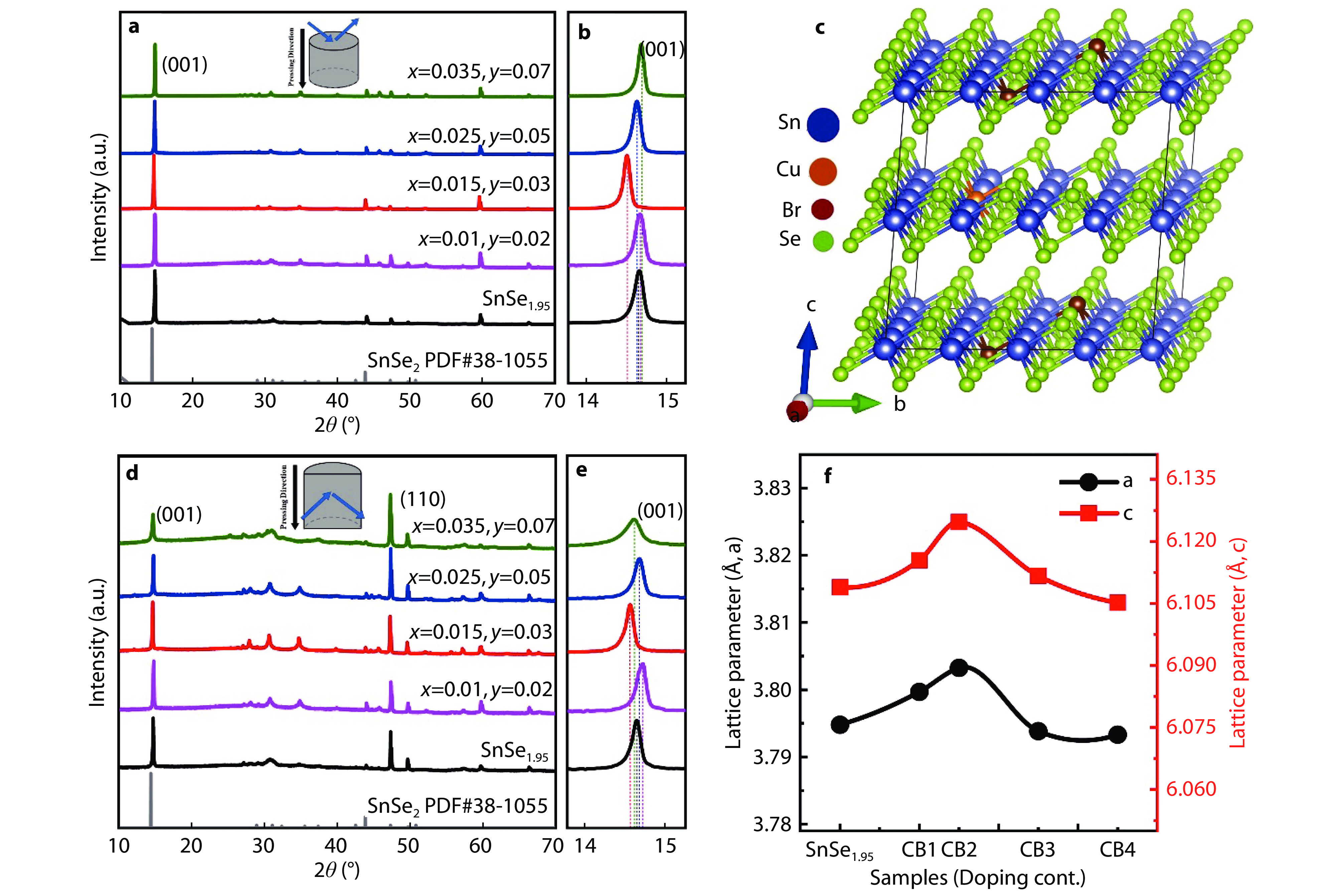
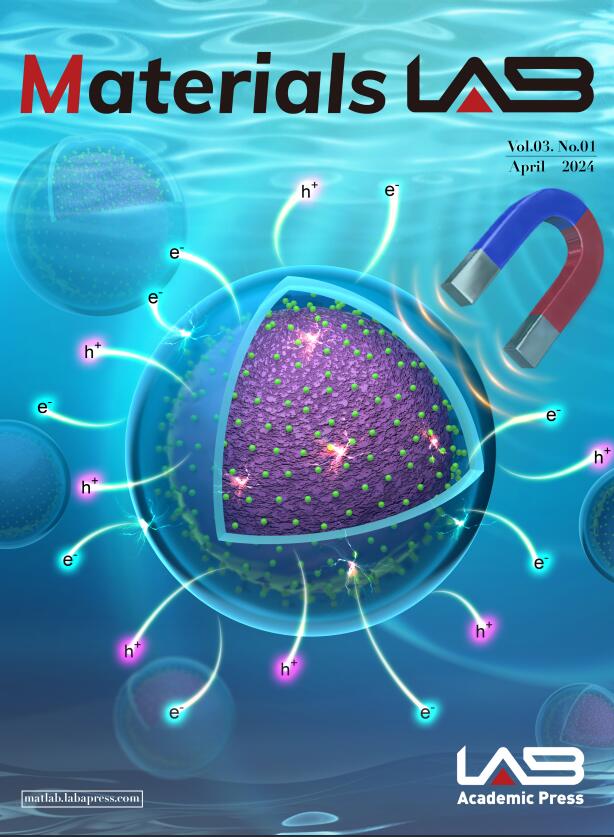
 DownLoad:
DownLoad:

